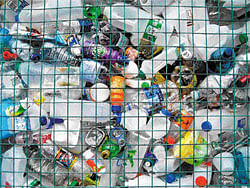Building rooms with used plastic

Diaz heads a non-profit organisation, My Shelter Foundation, which aims to find innovative solutions to fight climate change through sustainable, eco-friendly, low-cost structures. Over the years, the Foundation has embarked on several projects for sustainable construction, including earthquake-proof earthen schools, bamboo schools, and shelters for peanut farmers made out of peanut shells.
Recycling plastic bottles into building material now counts as one of the Foundation’s ‘green projects’, and has caught the attention of the architecture and construction industry in the Philippines. Architect Zigfrido Abella said My Shelter Foundation’s “bottle schools”, as they are called, are breaking new ground in sustainable construction.
The Foundation drew inspiration for these schools from Spanish-style adobe churches and buildings that incorporated glass bottles in Turkey and Mexico, which have withstood the test of time.
“We liquefy adobe and place them inside the bottles which serve as moulds or ‘building blocks’ for the school,” Diaz said in a press interview in San Pablo, Laguna, not far from Manila, capital of the Philippines.
The process started with gathering as many 1.5 to 2-litre plastic bottles as possible from restaurants and hotels. The soda bottles were then filled with liquefied adobe and left to dry for 12 hours. The bottles are arranged like bricks, stacked neatly to form walls, with cement holding the bottles in place to make the wall sturdy. It took roughly 5,000 bottles to complete one classroom.In the finished classroom, builders insert small holes and PVC pipes in between the bottle brick walls to serve as air vents.
This reduces the need for electric fans inside the classroom. Large windows on two walls, rafters above the doorway, and panels surrounding a wide doorway made of translucent glass bottles maximise the use of natural light. Fibreboards made of bamboo fibre, corn husk and rice hull, which are sourced locally, make up the back wall that separates two classrooms. When turned into bricks, the bottles made from synthetic resin (called polyethylene terephthalate, or PET) are very stable.
Architect Abella said these PET bottles, which underwent testing by engineering students, were found to be “even stronger than conventional hollow blocks, very durable, flexible and easily adaptable into conventional construction methods.” It took roughly a month to complete the first of eight planned classrooms.
Diaz is trying to gather the remaining 35,000 bottles he needs for construction, with various corporations and individuals donating them for free. My Shelter Foundation hops to complete the school in time for the opening of classes in June.
Deccan Herald is on WhatsApp Channels| Join now for Breaking News & Editor's Picks